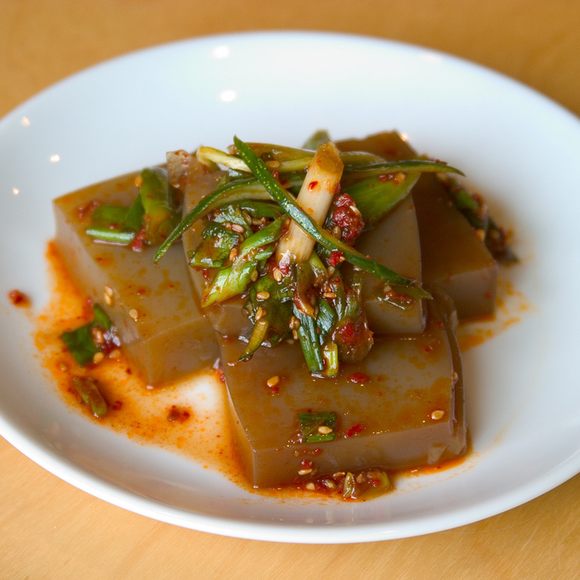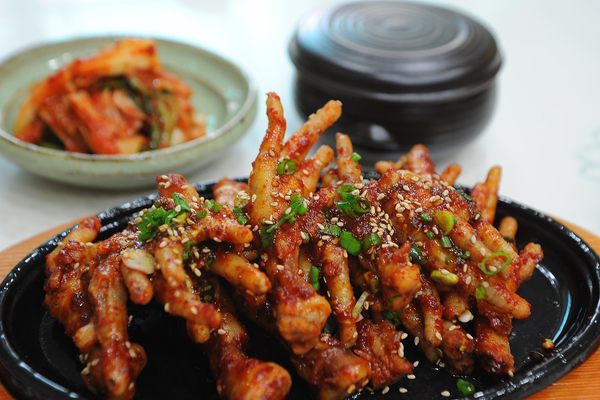Prepared Foods
Acorn Jelly
The nut goes from oak tree to savory, sesame-topped side in a matter of days.
It’s wobbly and soft, caramel-colored, and garnished with toppings such as sesame seeds, soy sauce, or pickled cabbage. In its prepared form, dotorimuk, or Korean acorn jelly, is a far cry from how its main ingredient looked when it fell off an oak tree.
Acorns have been a food source in many parts of Asia, Europe, and the Americas for centuries. Though they are a handy source of protein, calcium, and magnesium, acorns can’t be eaten straight from the tree for several reasons. Inside the shell, the raw nut is hard, foul-tasting, and somewhat toxic when eaten in moderate amounts. The toxicity comes from the acorns’ high levels of tannins (chemicals that are also present in other foods, such as red wine or black tea, but in safer amounts). You remove the tannins by soaking peeled acorns in water for up to one week (you’ll know it’s working when the tannins stain the water brown), then rinsing them. Once the acorns are safe, you grind the nuts, then heat the resulting powder with water until it turns into a jelly.
The end product is dotorimuk, which has a silky texture and mild, savory flavor when eaten plain. Its light taste makes it a great candidate for the many additional flavorings that can be added to it, making it saltier, sweeter, spicier, and/or tangier, depending on what the cook prefers. Chefs often serve it in slices atop a bed of lettuce, as a side dish known as dotorimuk-muchim.
The jelly is produced on an industrial scale in South Korea for use in restaurants and for sale in supermarkets. If you’d like to make the jelly yourself, you can either harvest your own acorns or simply buy premade acorn starch powder online. While there are other kinds of nut and legume jellies made in a similar fashion in Korea, dotorimuk is definitely the most classic, thanks to its great adaptability.
Where to Try It
-
Omokyo Torichon 오목교 토리촌
406-228 Mok-dong, Yangcheon-gu, Seoul, South KoreaThis health-focused restaurant incorporates local acorns into multiple dishes, including acorn jelly salad, acorn pancake, and acorn soup with noodles.
-
San Soo Kap San 2
171-10 Northern Blvd, Queens, New York, 11358-2730 , United StatesThis Korean BBQ restaurant in Flushing serves sides of acorn jelly.
Written By
a andreamacgSources
- mykoreankitchen.com/seasoned-acorn-jelly-dotori-muk-muchim/
- cooking.nytimes.com/recipes/1014095-korean-acorn-jelly-dotorimuk
- web.archive.org/web/20070814062201/english.tour2korea.com/05food/LocalFood/gw_08.asp?kosm=m5_3&konum=7
- books.google.com/books?id=2eW1CgAAQBAJ&pg=PA53&dq=acorn+jelly&hl=en&sa=X&ved=0ahUKEwjlieLbsZbZAhWKoFMKHWT9AnMQ6AEIPTAE#v=onepage&q=acorn%20jelly&f=false
- deliciousbiting.blogspot.com/2006/03/do-to-ri-mook-or-korean-jello.html
- modernseoul.org/2013/03/07/korean-acorn-jelly-or-dotorimuk-%EB%8F%84%ED%86%A0%EB%A6%AC%EB%AC%B5/
- www.10mag.com/korean-food-dotorimuk-201209/
- www.scientificamerican.com/article/is-reintroducing-acorns-into-the-human-diet-a-nutty-idea/













